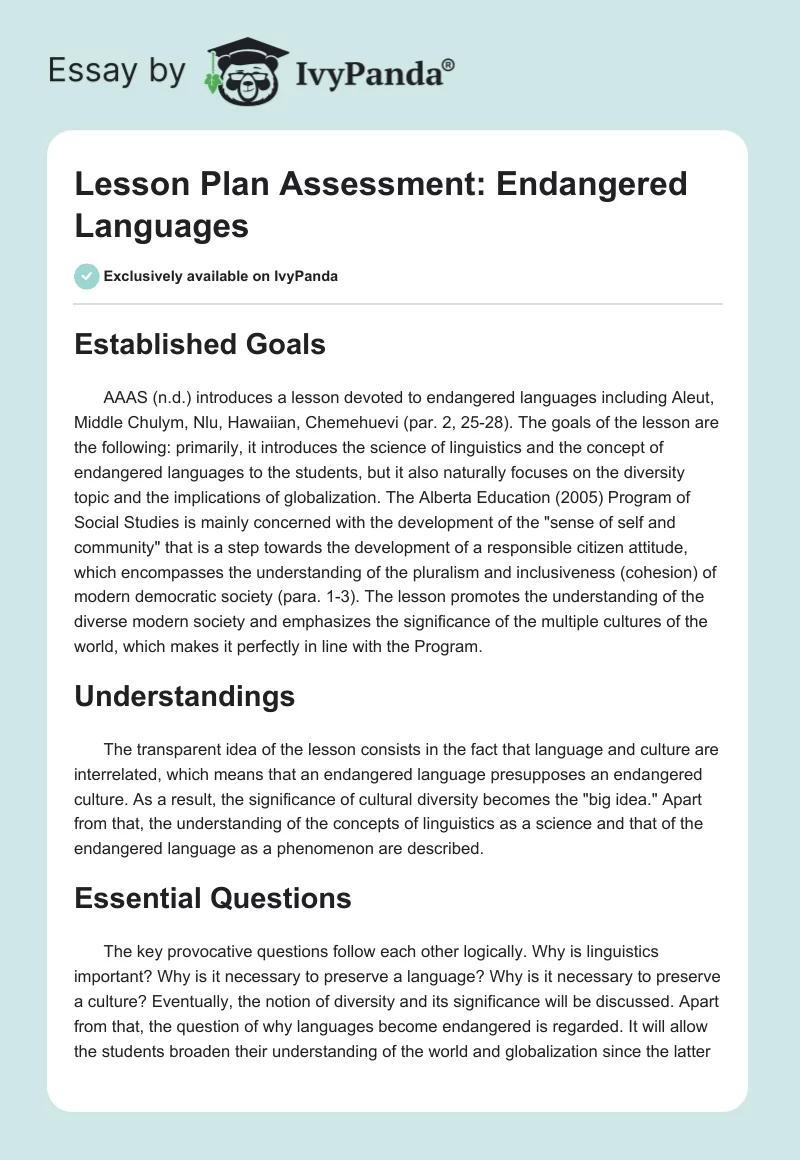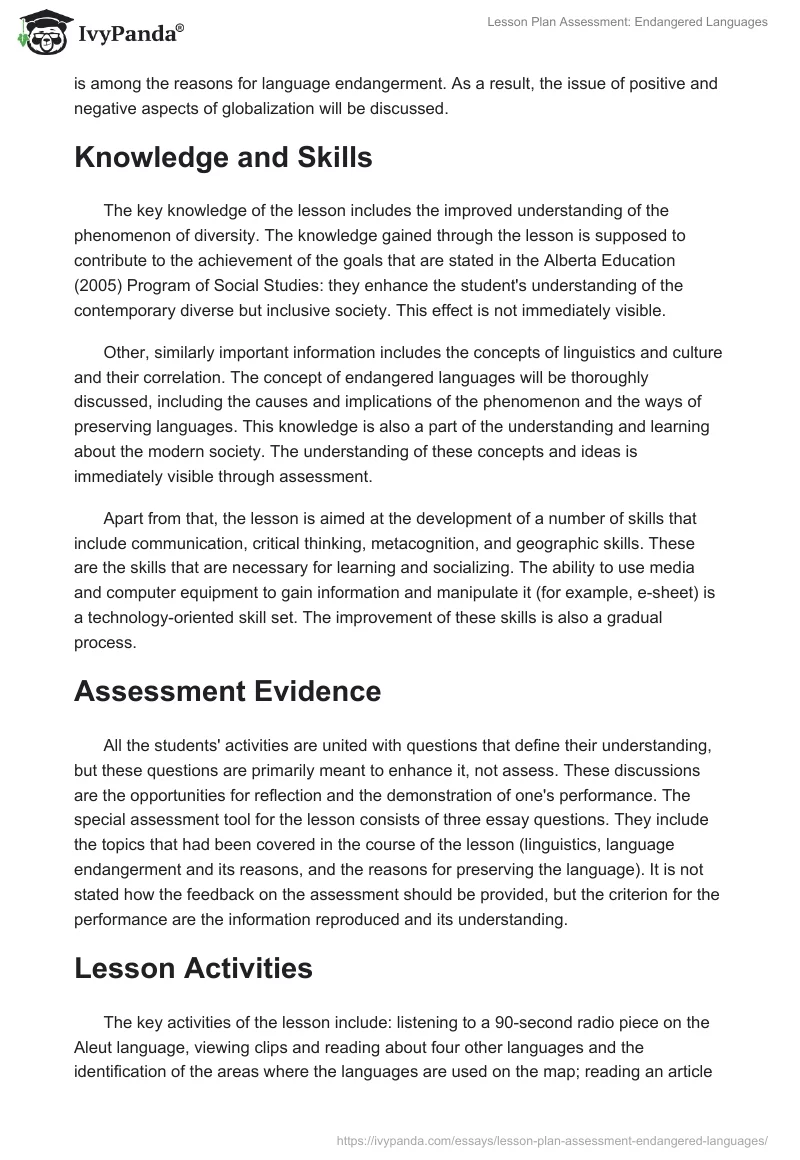Established Goals
AAAS (n.d.) introduces a lesson devoted to endangered languages including Aleut, Middle Chulym, Nlu, Hawaiian, Chemehuevi (par. 2, 25-28). The goals of the lesson are the following: primarily, it introduces the science of linguistics and the concept of endangered languages to the students, but it also naturally focuses on the diversity topic and the implications of globalization. The Alberta Education (2005) Program of Social Studies is mainly concerned with the development of the “sense of self and community” that is a step towards the development of a responsible citizen attitude, which encompasses the understanding of the pluralism and inclusiveness (cohesion) of modern democratic society (para. 1-3). The lesson promotes the understanding of the diverse modern society and emphasizes the significance of the multiple cultures of the world, which makes it perfectly in line with the Program.
Understandings
The transparent idea of the lesson consists in the fact that language and culture are interrelated, which means that an endangered language presupposes an endangered culture. As a result, the significance of cultural diversity becomes the “big idea.” Apart from that, the understanding of the concepts of linguistics as a science and that of the endangered language as a phenomenon are described.
Essential Questions
The key provocative questions follow each other logically. Why is linguistics important? Why is it necessary to preserve a language? Why is it necessary to preserve a culture? Eventually, the notion of diversity and its significance will be discussed. Apart from that, the question of why languages become endangered is regarded. It will allow the students broaden their understanding of the world and globalization since the latter is among the reasons for language endangerment. As a result, the issue of positive and negative aspects of globalization will be discussed.
Knowledge and Skills
The key knowledge of the lesson includes the improved understanding of the phenomenon of diversity. The knowledge gained through the lesson is supposed to contribute to the achievement of the goals that are stated in the Alberta Education (2005) Program of Social Studies: they enhance the student’s understanding of the contemporary diverse but inclusive society. This effect is not immediately visible.
Other, similarly important information includes the concepts of linguistics and culture and their correlation. The concept of endangered languages will be thoroughly discussed, including the causes and implications of the phenomenon and the ways of preserving languages. This knowledge is also a part of the understanding and learning about the modern society. The understanding of these concepts and ideas is immediately visible through assessment.
Apart from that, the lesson is aimed at the development of a number of skills that include communication, critical thinking, metacognition, and geographic skills. These are the skills that are necessary for learning and socializing. The ability to use media and computer equipment to gain information and manipulate it (for example, e-sheet) is a technology-oriented skill set. The improvement of these skills is also a gradual process.
Assessment Evidence
All the students’ activities are united with questions that define their understanding, but these questions are primarily meant to enhance it, not assess. These discussions are the opportunities for reflection and the demonstration of one’s performance. The special assessment tool for the lesson consists of three essay questions. They include the topics that had been covered in the course of the lesson (linguistics, language endangerment and its reasons, and the reasons for preserving the language). It is not stated how the feedback on the assessment should be provided, but the criterion for the performance are the information reproduced and its understanding.
Lesson Activities
The key activities of the lesson include: listening to a 90-second radio piece on the Aleut language, viewing clips and reading about four other languages and the identification of the areas where the languages are used on the map; reading an article on the process of saving an endangered language. All these activities are interlaced with the discussions. The W.H.E.R.E.T.O. the concept as defined by Wiggins (2005) can be applied to the lesson. The initial talk gives the students the overview of the lesson and helps the teacher to understand what ideas the students had had about the key concepts of the lesson. Apart from that, it incorporates “hooking” methods, for example, the introduction of the differences between languages (the lesson suggests comparing English to Korean or any other language) and the radio program that raises a number of questions.
The hooking methods of the main part of the lesson include video clips, and some of the teacher’s topics can be considered captivating (for example, the questions of children’s own experiences with languages). Naturally, the content of the lesson is equipping, and the teachers’ questions make the processes of learning and understanding easier. The opportunity the rethink and revise are offered several times throughout the lesson as the students are constantly offered to express their opinion both on the topic that was studied and the one that is being approached. The regular discussions also allow the students to evaluate their understanding (and deepen it). The lesson is highly organized but offers the possibility of modifications and customization, for example, in case the students are familiar with or speak a second language. To sum up, the lesson appears to correspond to the concept of Wiggins (2005).
Theory
Even though it is not named, the specific theory of learning that the lesson seems to use is the 21st Century Skills Framework as described by the Partnership for 21st Century Learning (2016). The subject of the lesson corresponds to the key subjects of the Framework (social studies and global awareness), the targeted skills include communication and collaboration as well as critical thinking; the media literacy skills are also developed among others.
Program of Studies
The lesson is very well aligned with the Alberta Education (2005) Program. The goals, vision, values, and knowledge are similar: the lesson raises a global issue and promotes global consciousness in the students, teaches them to value diversity and respect multiple worldviews, which corresponds to the program. The skills that are being developed are also in line, especially the cognitive ones (Alberta Education, 2005, para. 9-10). However, the Program focuses on Canadian experiences and settings; the lesson does not. This aspect, however, can be regarded as a disadvantage and an advantage: while it does not provide exclusively Canadian experiences, it offers a global view on the issue. Canadian experiences can be added if it is deemed necessary.
Also, the lesson is suitable from the point of view of the grades involved (6-8) and the general topic (social sciences).
Recommendations
The lesson appears to be well thought-out and organized; it is modifiable and likely to be modified due to the numerous opportunities for discussion. As children encounter, analyze, and produce knowledge, the scenario can develop. As a result, the only issue that can be noted is the problem of time. The lesson is filled with various exercises, and the time management can be difficult to control. It is a manageable issue though as, depending on the needs and possibilities of the class, the lesson can be modified, stretched into a couple of lessons, and so on. The absence of feedback instructions may also be regarded as a disadvantage, but it is also an opportunity of choosing suitable methods for the situation.
References
AAAS. (n.d.). Endangered Languages. Web.
Alberta Education: Studies K – Grade 12 (2005). (2005). Web.
Partnership for 21st Century Learning. (2016). Framework for 21st Century Learning. Web.
Wiggins, G. (2005). Overview of Understanding by Design and the Design Template. Web.


